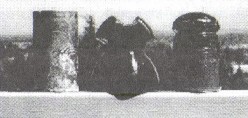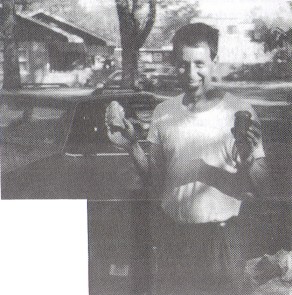East Coast Digging Adventure
by David Bethman
Reprinted from "Crown Jewels of the Wire", March 1997, page 21
After hearing the many stories from some of my bottle digging friends about
the digging opportunities on the East Coast, I knew it was time to give it a
try. Since I am currently flying halftime as a corporate pilot, I had a chance
to do what might be a once-in-a-lifetime dig. I recruited two bottle digging
friends, Russ West and Chris Harper to travel with me, and based on their trip
of two years ago, we decided to return to the area of Erie, Pennsylvania.

While
the interests of Russ and Chris would primarily be in bottles, I knew that it
was possible to find some unusual insulators. Russ's dad, who owns a travel
agency in Mt. Vernon, Washington, set us up with tickets and reservations. We
flew on Northwest Airlines from Seattle to Detroit, then Detroit to Erie.
It was
Chris's first time on an airliner, and he managed to do just fine, even though
we hit a little rough air descending into Erie. Russ had a busy "night
before" the flight and he slept most of the way. I entertained Chris with
stories about the noises heard on an airplane -- things like the wing blots
falling off or the landing gear leaving the airplane in flight.
We arrived in
Erie at about 10:00 p.m. and were met by our local contact. He took us to our
hotel where we unpacked our probes and tools. By the way, when we showed up at
SeaTac to go, Chris's probes and shovels were in a box that looked like a
bazooka, Russ's were wrapped in tarps, and mine looked like an oversize bass
guitar. The ticket clerks accepted them and they arrived safely in Erie.
Needless to say, they were the most important luggage we had.
Our first day was
spent doing some research at the library, and we found the library was moving
from downtown to a new location on the Bayfront Hiway. This meant that the maps
were not available to copy, so we had to make do with the 1865 maps. We started digging
that day about noon, and soon the bottles were coming out. Rather than relate
everything we found (which would be many thousands of bottles long), I'll kind
of describe items as they were found.
Having never dug on the East Coast before,
I was curious as to what type of bottles and odd insulators would be most common
and available there. I soon found out that due to the heat and humidity of the
summers, everyone drank something, and many times the bottles ended up down the
privy. I think of digging in my home state of Washington, where finding an
embossed beer or Hutchinson soda is very uncommon (and cause for celebration).
In Erie, every hole from the 1880's or newer usually had embossed beers and
sodas, sometimes lots of them.
I also had to learn a new system of dating homes,
in that the Civil War era homes and earlier have certain distinctive
characteristics in architecture and style that allows one to date them fairly
accurately. In the first week of digging, we dug many bottles. One hole had 100
embossed Erie beers, many of which were very rare, and worth between $20-30
each. In fact, we dug about 50 of one beer which, prior to this dig, had been
selling for about $65 each. We flirted with pontiled items, finding broken open
pontiled scroll flasks, and whole common open pontiled patent medicines and
unembossed open pontiled bottles.
Another difference between digging in
Washington and Pennsylvania is that many old style fruit jars were thrown away
in the 1870's. When you're down in a privy looking at an aqua jar base, it is
not usually a Ball Mason or similar vintage jar. It is usually an early 1858, or
very likely a wax sealer.
We dug lots of stoneware, including wax sealers,
butter crocks, big jugs, yellow-ware, Bennington, and other neat items. There is
a tremendous amount of stoneware in privies back east, some of it is really
nice. I sent home a yellow-ware chamber pot with a white center with blue
peacocks glazed in the middle. We found many broken jugs with salt-glaze and
cobalt decorations.
After a few days in Erie, the local collectors caught on to
us, and usually one or two were parked outside our motel room waiting for our
return from the day's digging. We used a rotation system to split up the finds,
with anything over $500 going into a final sale and split of the money after we
came home, but lesser items being divided up each day. After the first week of
digging, Chris and Russ received nicknames: Chris was called "Chief Brown
Cloud" for his ability to clear a privy at a moment's notice, and Russ was called "Dr.
Death" or
"Dr. Jack", after Jack Kevorkian, for his ability to break bottles
with his two-prong-fork!
As we got more accustomed to knowing where to find the
outhouses, we began to do better as our trip progressed. By the last week, we
were finding pontil pits behind each home we checked. Some of the bottles and
insulators were great. Behind a home that overlooked the old P.R.R., we dug two
insulators out of outhouses. Russ had gotten permission to dig behind an 1850's
home site, now a garden and lawn. He knew of my interest in insulators, and in
the past has pulled out items like an "E.C.& M.Co." and a
"California Electric Works" in Washington state. He knew just enough
to know when he had found an unusual item, not a common Hemingray or Brookfield.
I was digging in the neighboring yard when Russ ran over to the fence and
shouted that he had just found an insulator. Considering the age of the home we
were behind, I rushed over to the fence looking for threadless! He handed me a
crude dark aqua unembossed CD 127 no name, in great condition except for a minor
wire groove chip. I had brought John and Carol McDougald's Price Guide for
Insulators along on the trip, and I was eager to get back to the hotel to check
out this baby!
We ended up digging about 10 privies in the two backyards, and in
the last pit we found another insulator. This pit seemed somewhat disturbed, as
we were finding a wide range of bottles and china dating from the 1860's into
the 1890's. I probed the pit, Chris started it, and soon he was pulling out some
good keepers. About halfway down, Russ took a turn in the pit, and I kneeled
opposite the dirt pile to check for marbles, buttons and other small items that
he might throw out with the shovelfuls of dirt. Suddenly, an insulator appeared
in a scoop of dirt, unnoticed by Russ. I picked it up and immediately noticed
four evenly spaced projections jutting out around the dome of the aqua
insulator. AN EMMINGER! I jumped up and began to hop around, telling Russ and
Chris that we had just dug one of the rarest and most valuable insulators in the
world! I suppose I should add that we found only the top two-thirds of the
Emminger. Needless to say, we were pretty pumped up after this find!
On one of
the days, we dug behind what must have been a "crack house," as all
these skinny blonde and brunette gals kept coming and going, and visiting with a
big guy inside. He must have thought we were the cops or something, as he
watched us and finally wandered out to check us out after a while. Chris was
down five feet in a rich pit, and the bottles were coming out nicely!. The fellow
from the house finally believed that we were digging for bottles. When he first
came out, I said "Howdy, Pilgrim" in my best John Wayne imitation. He
looked at me and said, "Whatcha callin' me 'pilgrim' for, man, my ancestors
didn't come over on the Mayflower!"
Pretty soon he was back with something
in his pocket, a baggie with something in it. I was sure hoping it wasn't
cocaine he wanted to sell! He pulled out the baggie and it was full of baseball
and football cards! There was a Cal Ripkin, Jr. rookie card, John Elway, Kirby
Puckett rookie, Tony Gwynn, etc. etc. We didn't want to buy them as they might
be "hot', but the low price of $30 for all the cards overcame any moral
objection to the purchase! We also found a CD 102 Star, CD 145 Brookfield and CD
162 Brookfield in a new pit behind his home.
The last insulator found on our
trip came from digging behind an 1830 home located in the downtown area next to
the hospital. Russ probed out a pit that seemed to be very skimpy, with perhaps
one bottle in it. He dug it and the "bottle" turned out to be a
threadless insulator, a Wade style from the 1850's period! The wood covering had
long since rotted away, but the glass was in good condition.
I was also able to
purchase an unusual porcelain insulator, a medium cobalt blue Pittsburg style
cable.
We dug literally thousands of bottles and half a dozen insulators in the
three weeks we were there, and we had a really fun and interesting time. I hope
to make this an annual pilgrimage to look for both good bottles and insulators.

AN EMMINGER!! proudly displayed by
David Bethman, Ferndale, Washington.
VISITING WESTERN WASHINGTON? Stop at the Bottle Vault, I-5 Antique Mall, Exit
260 (I-5), Bellingham, WA Nice assortment of U.S. and Canadian glass and
porcelain insulators, bottles and fruit jars. DAVID BETHMAN, (360) 380-5770
|
